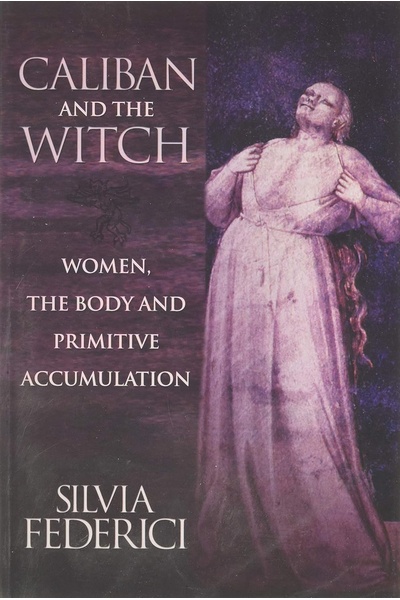Caliban and the Witch
A groundbreaking feminist re-examination of capitalist primitive accumulation that reveals how violent control over women's bodies became foundational to capitalist development.

📝 Book Review
“Caliban and the Witch” is a groundbreaking work published in 2004 by Italian-American scholar Silvia Federici that profoundly reinterprets the origins of capitalism through a unique feminist Marxist perspective, revealing the gender dimensions ignored by traditional historical narratives. Through this work, Federici not only challenges mainstream historical accounts but provides an entirely new theoretical framework for understanding the essence of capitalism.
Federici builds her analysis around the interconnected processes of primitive accumulation that Marx identified as foundational to capitalism, but she expands this framework to include what she terms the “enclosure of the body” — the systematic attack on women’s autonomy over their own reproductive capacity. Her work demonstrates how the transition to capitalism required not just the enclosure of common lands but the enclosure of women’s bodies, transforming them into instruments of labor reproduction under capitalist control.
The Witch Hunts as Capitalist Strategy
One of Federici’s most important arguments concerns the relationship between the 16th-17th century witch hunts and capitalist primitive accumulation. She argues that this seemingly religious persecution actually served the development needs of capitalism. Through systematic violent means, the ruling class successfully deprived women of control over their own bodies and reproduction, incorporating women’s reproductive capacity into the capitalist production system’s control mechanisms.
The witch hunts were not, as traditional accounts suggest, merely the product of religious superstition or misogyny, but rather a deliberate campaign to break women’s resistance to the new capitalist order. Women accused of witchcraft were often those who possessed knowledge of contraception and abortion, who lived independently without male protection, or who refused to accept the new sexual and social discipline required by emerging capitalism.
This analysis completely overturns our traditional understanding of the witch hunts, revealing the deep political-economic motivations behind them. The persecution of women as witches served to terrorize all women into accepting their newly circumscribed roles within patriarchal capitalist society.
The Enclosure of the Body
More profoundly, Federici proposes the innovative concept of “enclosure of the body.” She points out that control over women’s bodies was actually another form of enclosure movement. Just as capitalism deprived peasants of control over land through enclosure movements, the ruling class also used various means to transform women’s reproductive capacity into tools of capitalist reproduction.
This bodily enclosure was not merely physical but symbolic and social, redefining women’s roles and status in society. The process involved new laws criminalizing abortion and infanticide, the establishment of new institutions to monitor women’s sexual behavior, and the creation of new forms of family organization that subordinated women to male authority.
The enclosure of women’s bodies paralleled the enclosure of common lands in its violence and its function in creating the conditions necessary for capitalist accumulation. Both processes dispossessed people of their traditional means of subsistence and forced them into dependence on the market and wage labor.
The Origins of Unpaid Labor
Federici’s analysis of the origins of unpaid labor is equally groundbreaking. She deeply analyzes how housework was ideologically constructed as “natural” female duty, thereby becoming invisible unpaid labor within the capitalist system. This analysis not only reveals the economic value of housework but, more importantly, reveals how capitalism achieves free appropriation of women’s labor through gender division of labor.
This appropriation not only reduces capital’s reproduction costs but maintains and reinforces patriarchal power structures. Women’s unpaid reproductive labor — including childbearing, childcare, housework, and emotional support — subsidizes capital by reducing the cost of reproducing the workforce while simultaneously ensuring women’s economic dependence on men.
The invisibility of this labor is crucial to its exploitation. By defining reproductive work as natural expression of feminine love rather than socially necessary labor, capitalism secures this work without payment while maintaining the fiction that women are supported by their male partners rather than exploited by the system.
Contributions to Feminist Theory
“Caliban and the Witch” makes important contributions to feminist theory in multiple ways. First, it successfully connects Marxist and feminist analytical frameworks, providing a more comprehensive and profound social critical perspective. The work demonstrates that gender oppression and class exploitation are not separate systems but mutually constitutive forms of domination.
Second, it profoundly reveals the intrinsic connection between gender oppression and class exploitation, showing that these two forms of oppression are not mutually independent but mutually constitutive and reinforcing. This intersectional analysis challenges both traditional Marxism’s neglect of gender and liberal feminism’s neglect of class.
Furthermore, Federici’s historical analysis provides important historical perspective for understanding contemporary neoliberalism, helping us recognize that many contemporary problems actually have deep historical roots. Her work shows how current attacks on social reproduction — through austerity policies, privatization of public services, and attacks on reproductive rights — represent a continuation of the same logic that drove primitive accumulation.
Finally, this work deepens academic understanding of reproductive labor, making important contributions to the development of social reproduction theory. Federici’s analysis has been crucial in establishing social reproduction theory as a significant strand within contemporary Marxist feminism.
Global Impact and Contemporary Relevance
This book has had widespread and profound global influence. It sparked feminist reconsideration of primitive accumulation processes in academia, prompting many scholars to reexamine the neglected gender dimensions in capitalist development. The work has been particularly influential in decolonial feminism, providing tools for understanding how colonialism, capitalism, and patriarchy operated together to oppress indigenous women.
At the social movement level, it profoundly influenced gender analysis within anti-globalization movements, providing activists with important theoretical tools for understanding gender inequality in globalization processes. Federici’s analysis inspired critical research on contemporary land grabbing, helping researchers recognize the violent and predatory characteristics still present in contemporary capital accumulation.
More importantly, this book powerfully promoted the development of social reproduction theory, injecting new vitality into this important theoretical tradition. Contemporary movements for wages for housework, care work organizing, and reproductive justice all draw on insights from Federici’s analysis.
Understanding Contemporary Neoliberalism
Federici’s analysis provides extremely important insights for understanding contemporary problems. Her historical analysis helps us better understand the deterioration of women’s circumstances under neoliberal policies, showing that this deterioration is not accidental but an inevitable result of capitalist development logic.
The structural adjustment programs imposed on the Global South, for example, can be understood as a new form of primitive accumulation that particularly targets women’s subsistence activities and social reproduction. The privatization of public services forces women to compensate through increased unpaid care work, while cuts to social spending particularly harm women who depend on these services.
Her analysis of reproductive control reveals the deep political-economic logic behind it, helping us recognize that reproductive rights are not merely personal rights issues but political issues involving social power distribution. Contemporary attacks on reproductive rights — from restrictions on abortion access to forced sterilization of indigenous women — can be understood as attempts to maintain control over women’s reproductive capacity in the interests of capital accumulation.
Additionally, Federici provides important structural perspectives for understanding gender violence, showing that gender violence is not merely individual behavior but systematic means of maintaining existing power structures. The epidemic levels of violence against women globally can be understood as enforcement mechanisms for women’s subordination within capitalist patriarchy.
Finally, her analysis clearly points out that anti-capitalist struggle must include feminist dimensions; any anti-capitalist struggle that ignores gender oppression is incomplete. This insight has been crucial for contemporary left movements trying to build inclusive analyses and strategies.
Methodological Innovations
Federici’s methodological approach represents significant innovation in historical analysis. She employs what she calls “history from below” that centers women’s experiences and resistance rather than focusing solely on elite political and economic developments. This approach reveals historical processes invisible in traditional accounts that focus on state formation and economic policy.
Her use of diverse sources — including witch trial records, medical texts, demographic data, and artwork — demonstrates how feminist historians can reconstruct women’s experiences even when traditional sources are limited. This methodological innovation has influenced an entire generation of feminist historians.
The work also demonstrates the importance of connecting historical analysis to contemporary political struggles. Federici explicitly links her historical research to contemporary movements around reproductive justice, care work, and anti-capitalist organizing, showing how historical understanding can inform current practice.
Critiques and Debates
While “Caliban and the Witch” has been widely celebrated, it has also generated important debates within feminist scholarship. Some critics argue that Federici’s analysis may overstate the coherence of ruling class strategy in primitive accumulation, suggesting that the processes she describes may have been more contradictory and uneven than her account suggests.
Others have questioned whether the witch hunts can be understood primarily in economic terms, arguing for the continued importance of religious and cultural factors in understanding these persecutions. These debates have productively advanced scholarship on the transition to capitalism and the role of gender within it.
Some scholars have also noted the need to expand Federici’s analysis to better account for racial and colonial dimensions of primitive accumulation, particularly the role of enslaved women’s reproductive labor in capitalist development. This has led to important work on the intersection of slavery, colonialism, and women’s oppression.
Influence on Contemporary Movements
“Caliban and the Witch” has had significant influence on contemporary feminist and anti-capitalist movements. The work has been particularly important for the development of social reproduction theory as a framework for understanding contemporary capitalism’s dependence on unpaid care work.
The book has informed organizing around care work, from domestic workers’ movements to campaigns for universal childcare. Federici’s analysis helps these movements understand their struggles not as sectoral issues but as challenges to fundamental structures of capitalist exploitation.
The work has also influenced climate justice movements, particularly in understanding how environmental destruction affects women’s care work and subsistence activities. Federici’s analysis of the commons provides frameworks for understanding both historical enclosures and contemporary environmental struggles.
Her insights about the centrality of reproductive control to capitalist accumulation have informed reproductive justice movements, helping activists understand attacks on reproductive rights as part of broader economic and political projects rather than isolated cultural conflicts.
Theoretical Legacy and Future Directions
“Caliban and the Witch” has established Federici as one of the most important theorists of contemporary capitalism and its relationship to gender oppression. The work has inspired extensive scholarship on social reproduction theory, primitive accumulation, and the history of women’s resistance to capitalism.
Future research building on Federici’s insights continues to explore the relationship between capitalism and patriarchy in different historical and geographical contexts. Scholars are examining how contemporary forms of accumulation — from financialization to digital capitalism — continue to depend on women’s unpaid labor and the control of women’s bodies.
The work’s insights about the commons have also inspired research on alternative economic forms and feminist ecological perspectives. Federici’s emphasis on women’s traditional knowledge and subsistence activities provides frameworks for thinking about post-capitalist alternatives.
Conclusion: Capitalism, Patriarchy, and Resistance
“Caliban and the Witch” is not only an outstanding academic work but a key text for understanding the symbiotic relationship between capitalism and patriarchy. Through this work, Federici shows us the complexity of history and the urgency of contemporary struggle. She reminds us that to truly understand and change reality, we must recognize the deep connections between gender oppression and capitalist exploitation.
The book’s value lies not only in its profound historical analysis but in its theoretical guidance for contemporary liberation practice. In today’s era of deepening global capitalist crisis, Federici’s voice seems particularly precious and timely. She reminds us that any genuine social transformation must simultaneously challenge capitalism and patriarchy — only in this way can we build a more just and equal world.
Federici’s analysis reveals that women’s bodies and labor have been central to capitalist accumulation from its origins, not peripheral concerns that can be addressed after economic transformation. This insight demands that any progressive politics take seriously the question of social reproduction and the liberation of women’s bodies and labor from capitalist control.
The work ultimately argues that the struggles against capitalism and patriarchy are inseparable because these systems of oppression are historically and structurally intertwined. This understanding is crucial for building movements capable of transforming rather than merely reforming existing relations of exploitation and domination. In this sense, “Caliban and the Witch” provides both historical understanding and strategic direction for contemporary liberation movements.
Discussion
读书讨论
分享您对这本书的感想和看法,与其他读者交流见解
加入讨论
分享您对这本书的感想和看法,与其他读者交流见解
加载评论中...
Book Info
Related Topics
🛒 Get This Book
 Buy on Amazon
Buy on Amazon Related Books
读书讨论
分享您对这本书的感想和看法,与其他读者交流见解
加入讨论
分享您对这本书的感想和看法,与其他读者交流见解
加载评论中...

